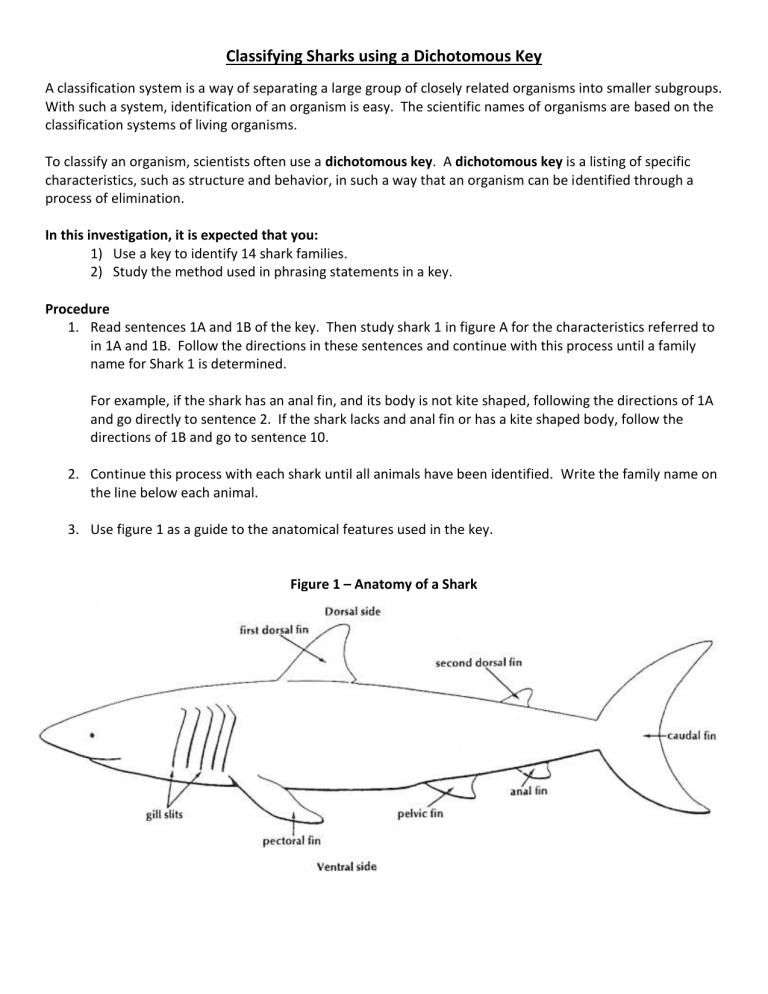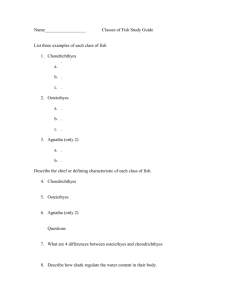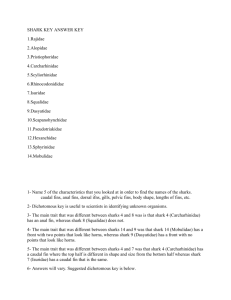
Classifying Sharks using a Dichotomous Key
A classification system is a way of separating a large group of closely related organisms into smaller subgroups.
With such a system, identification of an organism is easy. The scientific names of organisms are based on the classification systems of living organisms.
To classify an organism, scientists often use a dichotomous key. A dichotomous key is a listing of specific characteristics, such as structure and behavior, in such a way that an organism can be identified through a process of elimination.
In this investigation, it is expected that you:
1) Use a key to identify 14 shark families.
2) Study the method used in phrasing statements in a key.
Procedure
1.
Read sentences 1A and 1B of the key. Then study shark 1 in figure A for the characteristics referred to in 1A and 1B. Follow the directions in these sentences and continue with this process until a family name for Shark 1 is determined.
For example, if the shark has an anal fin, and its body is not kite shaped, following the directions of 1A and go directly to sentence 2. If the shark lacks and anal fin or has a kite shaped body, follow the directions of 1B and go to sentence 10.
2.
Continue this process with each shark until all animals have been identified. Write the family name on the line below each animal.
3.
Use figure 1 as a guide to the anatomical features used in the key.
Figure 1 – Anatomy of a Shark
Dichotomous Key to Shark Families
1. A. Body kite-like in shape (if viewed from the top) ..................................Go to statement 12
B. Body not kite-like in shape (if viewed from the top) ............................Go to statement 2
2. A. Pelvic fin absent and nose saw-like ...................................................... Family Pristiophoridae
B. Pelvic fin present .......…........................................................................ Go to statement 3
3. A. Six gill slits present ...........................................................................…..Family Hexanchidae
B. Five gill slits present ......................................................................…….. Go to statement 4
4. A. Only one dorsal fin ..........................................................................…...Family Scyliorhinidae
B. Two dorsal fins ..................................................................................... Go to statement 5
5. A. Mouth at front of snout…………..........……………………………………….…….… Family Rhinocodontidae
B. Mouth on underside of head ............................................................... Go to statement 6
6. A. Head expanded on side with eyes at end of expansion ……………….….. Family Sphymidae
B. Head not expanded .............................................................................. Go to statement 7
7. A. Top half of caudal fin about the same size as bottom half …………….... Family Isuridae
B. Top half of caudal fin different in size than bottom half ……….…………. Go to statement 8
8. A. First dorsal fin very long, almost ½ total length of the body….………… Family Pseudotriakidae
B. First dorsal fin regular length ……………………..................................…….. Go to statement 9
9. A. Caudal fin very long, almost as long as entire body ………………………... Family Alopiidae
B. Caudal fin regular length ................……………………………………………....…. Go to statement 10
10. A. A long needlelike point on end of nose ............................................... Family Scapanorhynchidae
B. Nose without long point ...................................................................... Go to statement 11
11. A. Anal fin absent ....................................……………………………………….…..... Family Squalidae
B. Anal fin present ..........................................……..................................... Family Carcharhinidae
12. A. Small dorsal fin present near tip of tail ................................................ Family Rajidae
B. No dorsal fin present near tip of tail ..................................................… Go to statement 13
13. A. Front of animal with two horn-like appendages .................................. Family Mobulidae
B. No horn-like appendages……….............................................................. Family Dasyatidae



